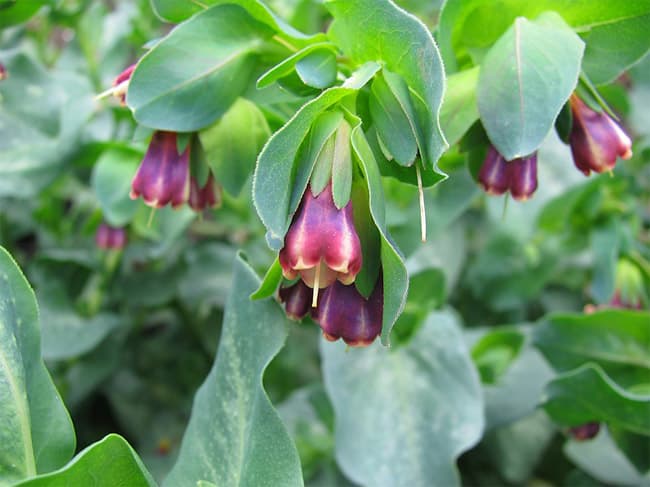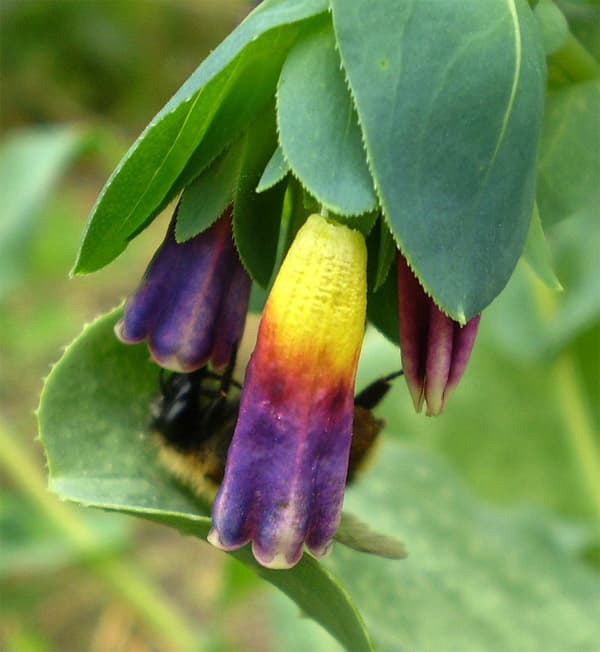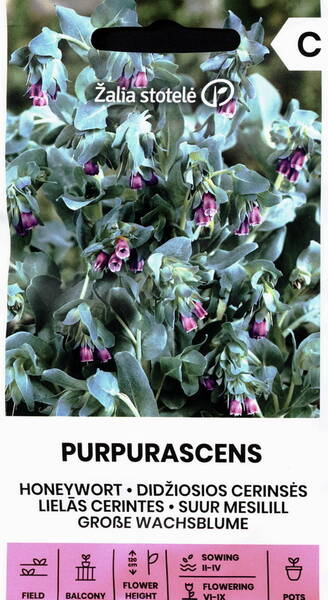Your shopping cart is empty!
Honeywort "Purpurascens"
Blue Shrimp Plant (honeywort, yellow candy) - Cerinthe major.
Despite the delicate beauty and elegance, this plant has not yet gained much popularity ...
Its bluish-green leaves, covered with a thin wax coating, are located on stems up to 50 cm high.
Small tubular flowers about 3 cm long have a two-tone dark purple with a light yellow colour, attracting many bees and bumblebees.
During the flowering period, new brushes are constantly formed at the top of the shoot, so the plant looks decorative for a long time.
Caring for a wax plant is not difficult. However, he did not enjoy success until new cultivated varieties appeared.
For example, the blue-leaved form "Purpurascens" has even become fashionable among art nouveau gardeners.
They are very fond of an unusual plant, the tops of which look as if they have been dipped in blue paint ...
In addition to this variation, "Atropurpurea" and "Kiwi Blue", belonging to the same group, became known. They differ from the original form only in the colour of the leaves and flowers.
In "Purpurascens" the corollas are not completely bicolour, although they retain the transition from pure violet to purple.
This plant looks best in combined plantings with other plants planted in open ground (in containers, its plantings do not make the proper impression).
Regardless of where the plant is placed (in a pot or in a flower garden), a lighted place should be chosen for it.
This Mediterranean native really loves heat and direct sunlight, but the soil dries out quickly in containers, so they have to be covered from the too hot midday sun.
Honeywort is propagated by sowing seeds, usually in open ground in April-May.
1,0 g = 18 seeds.
Despite the delicate beauty and elegance, this plant has not yet gained much popularity ...
Its bluish-green leaves, covered with a thin wax coating, are located on stems up to 50 cm high.
Small tubular flowers about 3 cm long have a two-tone dark purple with a light yellow colour, attracting many bees and bumblebees.
During the flowering period, new brushes are constantly formed at the top of the shoot, so the plant looks decorative for a long time.
Caring for a wax plant is not difficult. However, he did not enjoy success until new cultivated varieties appeared.
For example, the blue-leaved form "Purpurascens" has even become fashionable among art nouveau gardeners.
They are very fond of an unusual plant, the tops of which look as if they have been dipped in blue paint ...
In addition to this variation, "Atropurpurea" and "Kiwi Blue", belonging to the same group, became known. They differ from the original form only in the colour of the leaves and flowers.
In "Purpurascens" the corollas are not completely bicolour, although they retain the transition from pure violet to purple.
This plant looks best in combined plantings with other plants planted in open ground (in containers, its plantings do not make the proper impression).
Regardless of where the plant is placed (in a pot or in a flower garden), a lighted place should be chosen for it.
This Mediterranean native really loves heat and direct sunlight, but the soil dries out quickly in containers, so they have to be covered from the too hot midday sun.
Honeywort is propagated by sowing seeds, usually in open ground in April-May.
1,0 g = 18 seeds.

This plant is definitely a MUST HAVE!
Pale grey-green mottled foliage terminates in stunning, color-changing blue to purple bracts, which, in turn, surround the most graceful bell flowers.
Native to the Mediterranean region of southern Europe, Cerinthe major was only recently introduced to cultivation.
Grown as an annual in all zones, readily self-seeds but can also survive milder winters.
Easy to germinate and fairly carefree, prefers full sun to part shade. 18-24 inches in height. Attracts bees and hummingbirds, too.
Stunning and fascinating!

Eng.: Blue Shrimp Plant, honeywort, yellow candy. Suom.: Vahakukka. Sven.: Stor vaxblomma.













